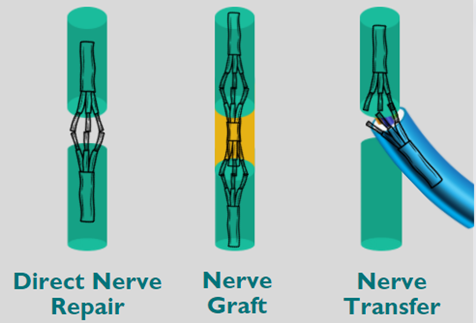Surgical Repair of a Nerve
Like electrical cords, 43 pairs of peripheral nerves extend from the spinal cord and enable movement, coordination and sensation throughout the body. The pain, tingling, numbness and other discomforts of peripheral nerve injuries can often be treated successfully with physical therapy and other nonsurgical methods. But in some cases, surgery offers the best chance of lasting relief.
Nerve repair surgery aims to restore function and sensation that was partially or completely lost due to nerve damage. For example, if a nerve injury caused paralysis in the arm, the surgery aims to return movement and sensation to the arm.
Types of Nerve Repair Surgery
There are different ways to repair a damaged nerve and restore its function. They include:
Direct Nerve Repair
When a nerve is cut sharply (e.g., with glass or a blade), sometimes the ends can be connected back together. This is called direct nerve repair and is usually the first method a surgeon considers.
During this procedure, a surgeon — who may first trim severely damaged tissue at the ends of a nerve — brings the ends together and connects them using a technique such as:
- Suturing or sewing the nerve ends together
- Gluing the nerve ends together with a special glue
All of these are delicate procedures that require a skilled nerve surgeon.
Nerve Grafting
A nerve graft is used to bridge a gap between the ends of a damaged nerve when the gap is too big to reconnect, which can happen after blunt or crush injuries, or after previous failed repairs. Nerve grafting is similar to grafting of skin or bone. A piece of nerve tissue is taken from somewhere in the body where it is not vital (or from a cadaver) and placed where it is needed.
Nerve Transfer
When reconnecting the ends of a damaged nerve is not a good option, a nerve surgeon may recommend a nerve transfer. During this procedure, a healthy, redundant donor nerve is rerouted to connect to the nonfunctioning, damaged nerve. As the nerve fibers regrow, movement and sensation are restored to the muscles and skin supplied by the damaged nerve.

Who may need nerve repair surgery?
A person may need surgery to repair nerves that were torn, stretched, compressed or otherwise damaged beyond their ability to heal. This can happen for various reasons, including:
- Traumatic accidents, especially accidents involving vehicles moving at high speed, such as all-terrain vehicles, or machinery with blades, such as a saw. One area likely to be hurt in a high-velocity crash is the brachial plexus — the branches of nerves that emerge from the spinal cord at the neck and pass through the shoulders into the arms and hands. Damage to the brachial plexus, if not treated successfully, can lead to lasting, severe pain and disability.
- Nerve tumors, such as schwannoma and neurofibroma, can form along a nerve anywhere in the body. While these tumors can often be removed without significant injury to the nerve, there are cases when the tumor or the repair injures the nerve, requiring further nerve surgery.
- Nerve entrapment (when a nerve is compressed by surrounding tissues). Although trapped nerves may need surgery to free them, they don’t always need to be repaired. Surgical nerve repair may be necessary if one of these conditions caused significant nerve damage:
- Ulnar nerve compression (affecting nerves in the arm)
- Peroneal nerve compression in the knee (including foot drop)
- Tarsal tunnel syndrome, which involves nerves passing through the ankle into the foot
An Innovative Approach to Nerve Repair | Santi’s Story
Santi's sciatic nerve was severed in a boating accident, paralyzing his right leg. He and his family traveled from Texas to Baltimore, where they met with neurosurgeon Allan Belzberg and orthopaedic trauma surgeon Greg Osgood. Together, the two surgeons collaborated to offer a novel way to repair Santi's leg and get him back to the water.
What happens during nerve repair surgery?
The details of nerve repair surgery differ depending on the method of repair (direct, graft or transfer) and the location of the injury. Typically, you will be asleep under general anesthesia while a surgeon:
- Makes one or several incisions to access the injury and assess the damaged nerve under a high-magnification microscope
- Removes severely injured or scarred nerve tissue from the ends of the damaged nerve
- Reconnects the ends of the nerve directly, by using a graft or by performing a nerve transfer. Nerve fibers need to be aligned precisely under a microscope to make these treatments effective.
Depending on where in the body the nerve injury has occurred, multiple surgeons could be involved in planning and performing a nerve repair. Specialists may include a neurosurgeon, a plastic and reconstructive surgeon, an orthopaedic surgeon and others.
Peripheral Nerve Surgery at Johns Hopkins
Our experts at the Johns Hopkins Peripheral Nerve Surgery Center are well-versed in all types of nerve repair, including nerve transfers and nerve grafts. We use a holistic approach, creating an individualized treatment plan for each patient.
Recovery After Nerve Repair Surgery
Once you wake up from anesthesia, your doctor will discuss the surgery results with you. You won’t be able to drive, so you should arrange for someone to take you home. Before you leave, your surgeon will provide detailed instructions regarding your recovery, which may include:
- Wearing a sling or a brace to reduce movement in the body part that had surgery
- Attending physical therapy sessions to keep the joints moving and eventually to strengthen the muscle supplied by the damaged nerve, as it starts recovering function
- Coming back for follow-up visits
- Limiting certain activities
Recovery after a nerve repair surgery takes time — often several months or longer. The length of recovery depends on the distance the nerve fibers need to grow from the repair spot to the muscle and skin the nerve supplies. Nerves grow at a rate of about an inch per month, so the further the injury is from the muscle, the longer it will take to restore function.





